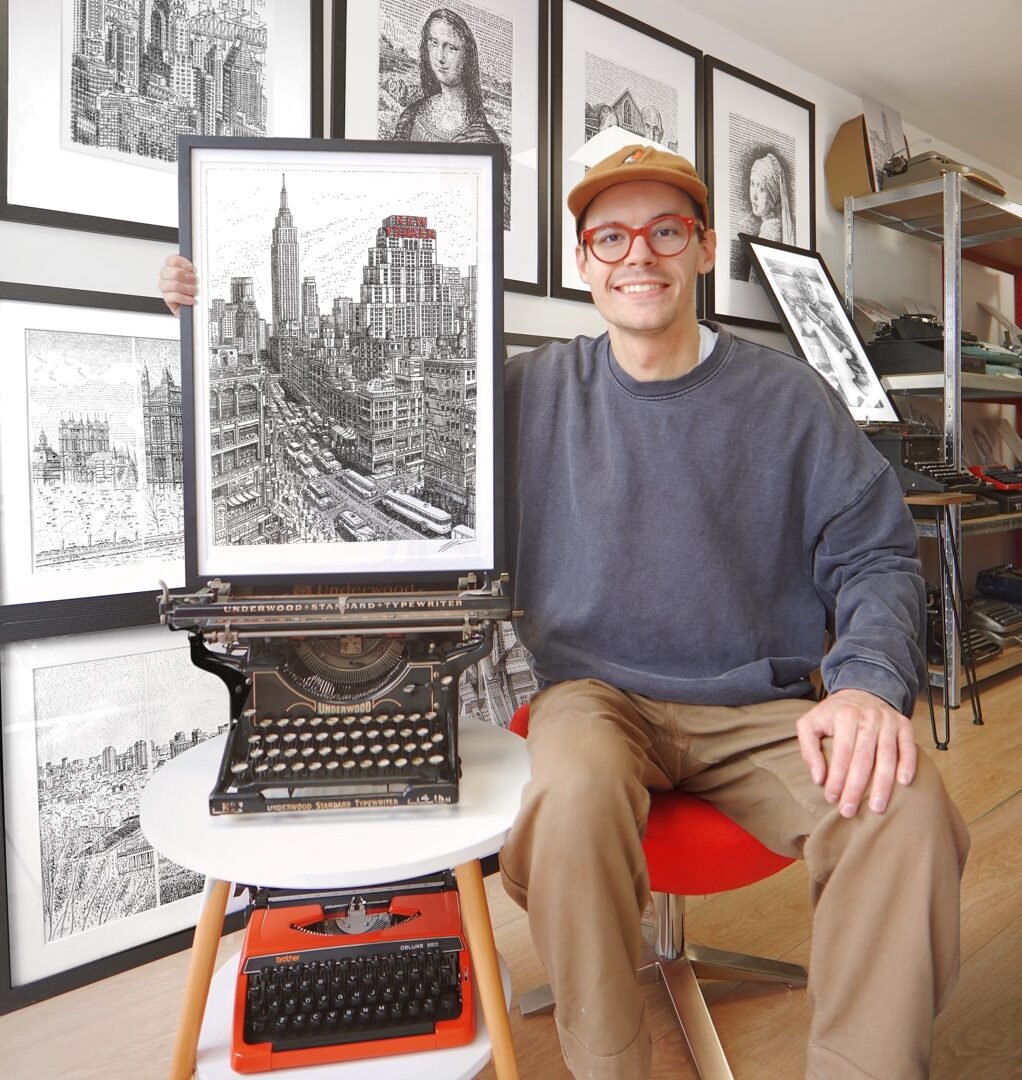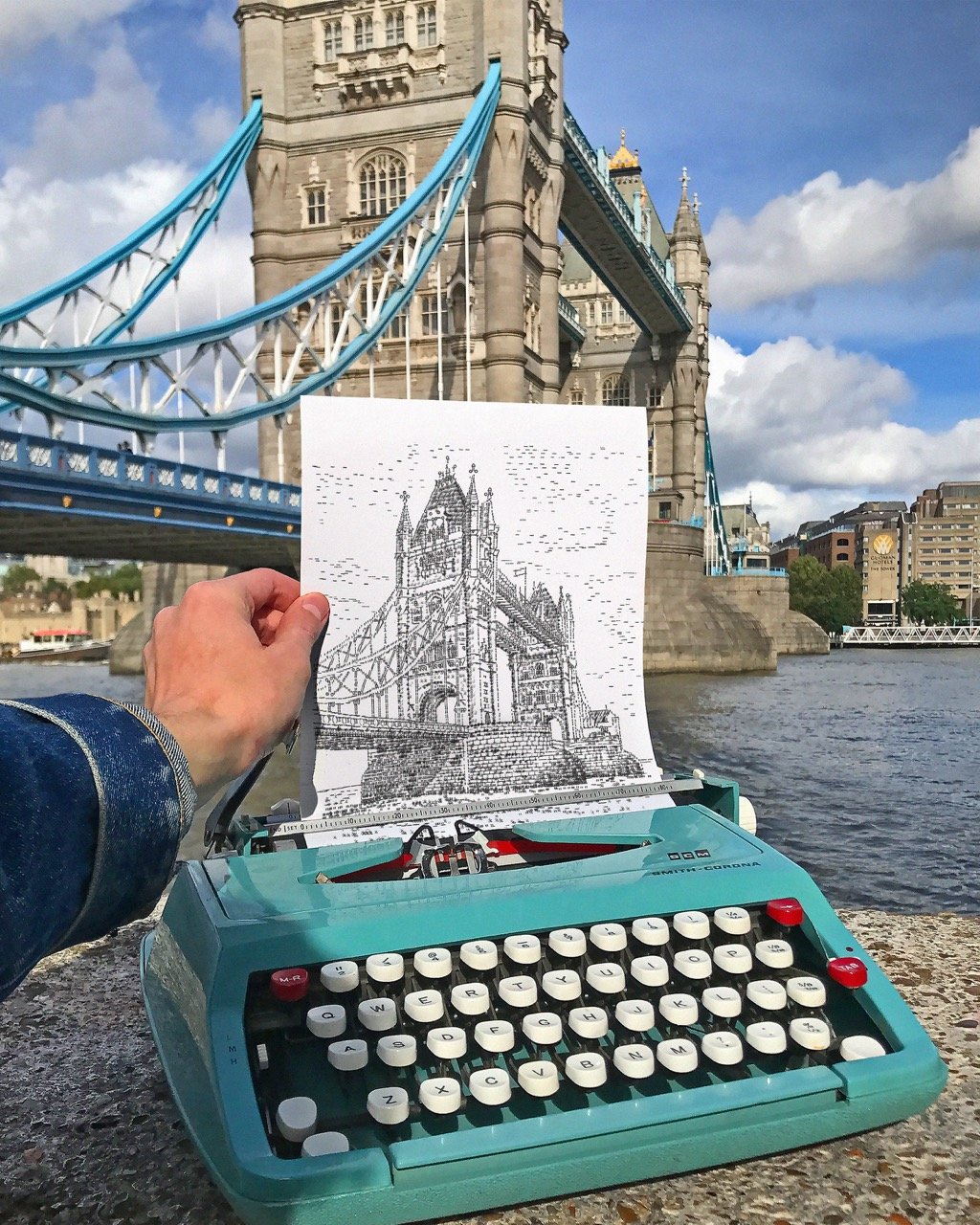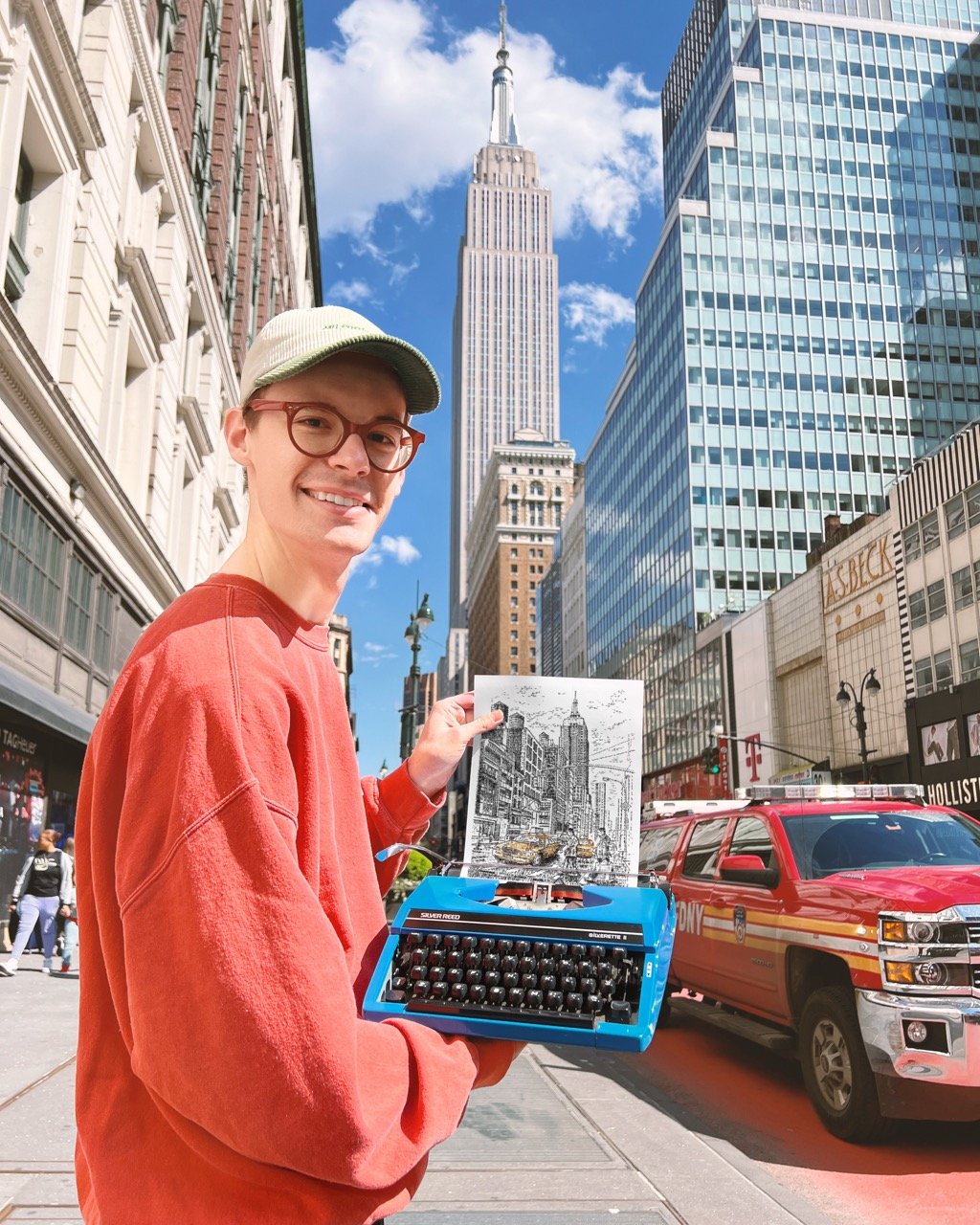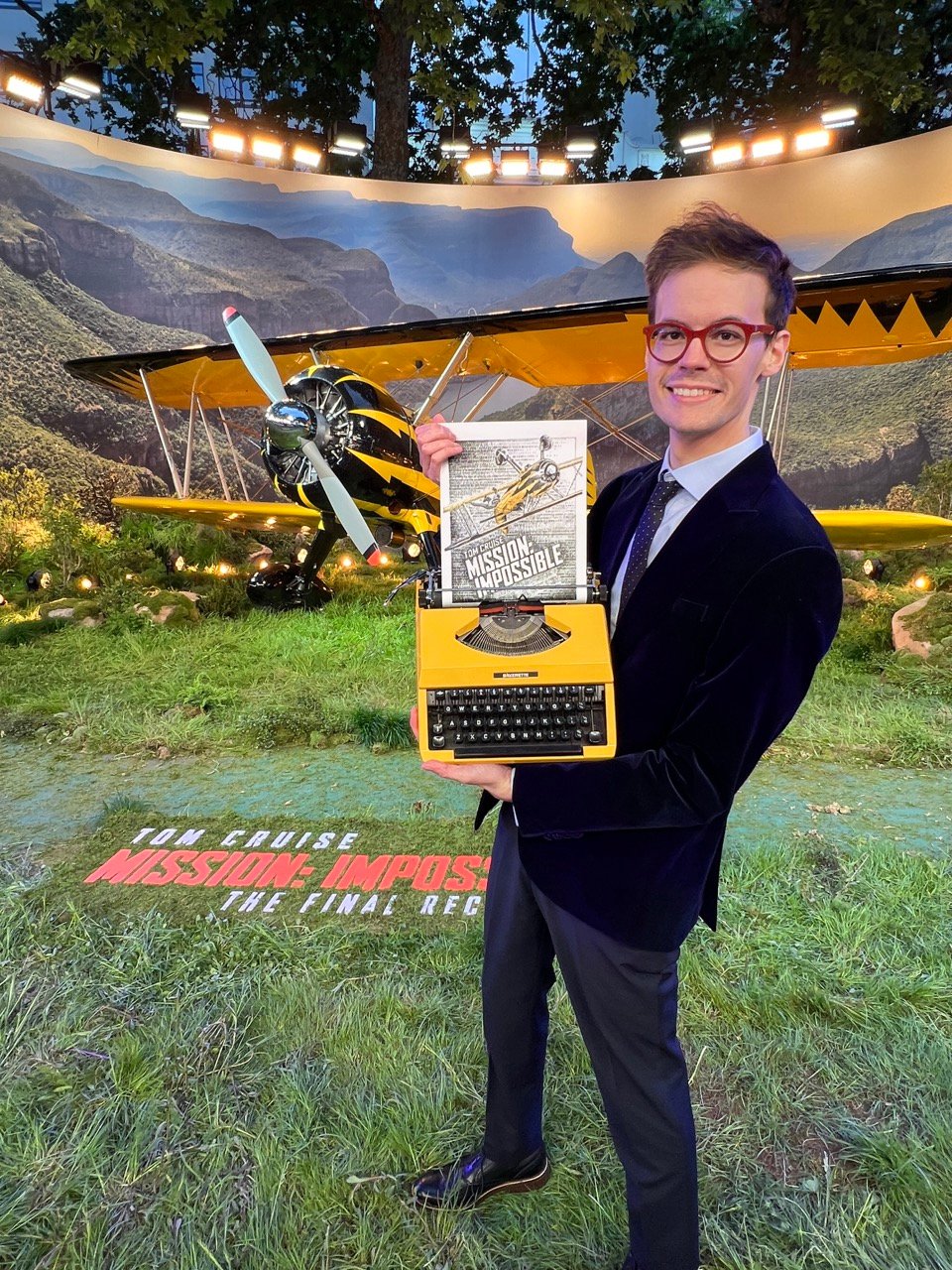James Cook and the Precision of Typewriter Art
An Interview with James Cook By Ollimono Magazine | 11th September 2025
In a world where attention is captured by 30-second AI videos and endless prompts, James Cook is an artist who types his drawings on a vintage typewriter. He transforms each keystroke into meticulously detailed portraits, cityscapes, and architectural landmarks. What might seem like a novelty at first glance is actually a precise, disciplined craft that reflects years of training and hard work.

James studied architecture at UCL in London. For a long time, he planned to become an architect. During school, he came across the story of Paul Smith, an American artist with cerebral palsy who created art with a typewriter. Inspired by this, James tried typing his own drawing as part of a class project. He has been doing it ever since.
“I started posting my work on Instagram in 2014,” he says. “At the time, I was still studying architecture, and commissions were just a way to pay the rent. I didn’t imagine it would become my full-time career.”

“I’m definitely an artist with an architectural mind”
James has completed over 350 artworks and built an international audience of over 800 thousand followers on Instagram alone. His pieces can take weeks to complete. Some contain over a million typed characters.
His architectural background is visible in the way he works. “Architecture taught me discipline. You were constantly surrounded by talented people, and your work was judged against everyone else’s. That experience gave me the drive to keep pushing and improving.”
The way James creates his artworks is a true expression of high-performance. “I nearly always work from a reference image, and that can come from different sources. Sometimes I use my own photography. Other times, especially if I need an aerial or more unusual angle, I might turn to tools like Google Maps’ 3D view to build the perspective, such as US landmarks as I am based in the UK.
Often the reference isn’t just one photo. It’s a collage of different images stitched together and composed in Photoshop. Getting that right can sometimes take just as long as typing the final artwork. The layout stage is crucial, especially for architectural scenes where composition matters. “
Preparation is everything, but the actual typing is even more impressive: “When it comes to actually typing, I’ve developed a method to lightly plan things out directly on the page. Each typewriter uses an ink ribbon, and once a ribbon is dried out, it becomes almost like a sketching tool. I’ll use an old, dry ribbon to tap out the rough structure of the piece, just enough to see proportions and placement without it being too dark or permanent. Once I’m happy with the layout, I’ll switch to a fresh, ink-rich ribbon and begin building up the final image.”
“Architecture left me with a sour taste”
James admits that his time in architecture school was not easy. The course was competitive, the pressure constant, and the vision of becoming an architect started to feel more like a burden than a dream. “It broke my heart a little,” he says. “I loved drawing buildings, but the idea of spending my life designing them wasn’t what I had imagined.” He found the profession weighed down by long hours, rigid systems, and a slow path to creative independence. “While I enjoy drawing buildings, I quickly realised that the designing aspect was the part I enjoyed the least.” The intensity of those years left him disillusioned with the profession, yet the discipline and resilience he gained from that struggle became the foundation for his later success as an artist.

“Typing artwork is my form of meditation”
James describes his process as both technical and calming. He works long hours in his studio at Trinity Buoy Wharf in London, typing from morning until evening, usually with automotive podcasts playing in the background.
“I enjoy the repetition. It helps me focus. A whole day can go by and feel like minutes.”
He uses symbols intentionally. “I’ve learned which letters, numbers, and punctuation marks work best for different effects. For instance, the “@” symbol is fantastic for creating soft shading when overlapped, making it ideal for capturing smooth skin tones in portraits. The brackets “()” are perfectly scaled for typing the pupils of eyes at A4 size, and when it comes to architecture, brick or stonework can be meticulously reproduced by aligning underscores “_” next to each other, with capital “I” characters spaced in between to form the bonds between the bricks.”
Many artworks also contain hidden messages or personal memories, especially in the scenes of London.
“Every typewriter has its own personality”
James Cook’s fascination with typewriters goes beyond their function, they are characters in his creative story. Over the years, he has amassed a collection of more than 100 machines, each offering a distinct keystroke feel, alignment, or tonal nuance. His go-to daily workhorse is a 1963 Olympia SG3, cherished for its reliability and familiar rhythm.
The first typewriter in James’ life found him itself, like a miracle: “my very first typewriter: a lime green Oliver Courier from around 1953 or 1954. I picked it up completely by chance. While walking through the high street with my dad, chatting about how I was hoping to find a typewriter in one of the local junk shops, an elderly couple overheard us. They kindly offered me theirs on the spot. I had never even touched a typewriter before, but I took it home and started experimenting. The Woolworth Building was the result.”
Recently, James brought this collection into the spotlight with two major exhibitions. One was a showcase at Trinity Buoy Wharf in April 2022, where he displayed over 50 of his typewriter artworks alongside 25 of his machines. Visitors were invited to participate in free workshops and witness live demonstrations of his process. Another notable exhibition titled Ten Years Typing: A Decade of Typewriter Art took place in London in late 2024 at theprintspace Gallery. This retrospective featured both archive pieces and new works such as the Brooklyn Bridge and Golden Gate Bridge, celebrating his first ten years as a typewriter artist.
These exhibitions turned his collection into more than tools, they became part of the narrative, showing not just his creations but also the instruments that make them possible.

“I love working. I get energy from being productive”
For James, art is not just creative, it’s operational. He runs the business himself, answering emails, editing videos, coordinating commissions, and maintaining a consistent posting schedule.
He starts his day with arriving at his office, making a cup of tea and writing a task list for the day. “Most of the day is spent in front of the typewriter, tapping away for hours on end. It’s repetitive, but that’s part of what I love about it. Around midday, I take a break for lunch. If it’s midweek and I feel like I need a little pick-me-up, I’ll head to The Orchard Café at Trinity Buoy Wharf. My go-to is a salt beef Reuben and a raspberry doughnut, highly recommended. It’s one of the few moments in the day where I step away and treat myself to something small. Aside from that, the rest of the day is usually a mix of typing, editing.”
This routine may seem like nothing remarkable, but James Cook sees this as part of his high-performance mindset, doing something that combines natural talent with consistent effort.
“Go slow to grow”
James produces about 20 artworks a year. That’s the limit of what he can physically create. But this limitation adds meaning. Each piece is intentional. Each one matters.
“It has taken me ten years to reach this point. The early years were slow, but they were necessary. If it had happened too fast, I don’t think it would have lasted.”
His most recent work, a night-time scene of Times Square, includes over a million typed characters in color. The limited edition prints sold out in a week, and the video received over 30 million views online.
“From Hollywood sets to international galleries”
James’s work has reached audiences far beyond his London studio. He was commissioned to create a piece for Mission: Impossible – Dead Reckoning Part One, which appeared on the film’s red carpet premiere. That project was especially memorable because his sister was by his side, sharing in the experience. His portraits have since been featured in exhibitions across the UK and internationally, and his large-scale cityscapes such as Times Square and the Manhattan skyline have drawn widespread attention online, with videos reaching tens of millions of viewers. Alongside private collectors, he has also produced commissions for public figures and cultural institutions, making his typewritten artwork part of both popular culture and contemporary art circles.
“Why James Cook belongs in OLLIMONO”
At OLLIMONO, we celebrate people who live and create with intention, discipline, and a high-performance mindset. James Cook represents exactly that. His work is not only visually striking but also rooted in structure, patience, and a relentless pursuit of craft, values that resonate with athletes, architects, and visionaries alike. He is also a very real person, as he showed in our original interview, where he openly shared personal experiences, the struggles he has faced, the support he has received, and the hopes he carries for the future. By typing out entire worlds, letter by letter, James reminds us that high performance is not always about speed or scale, but about focus, consistency, and the courage to build a life around what you love.